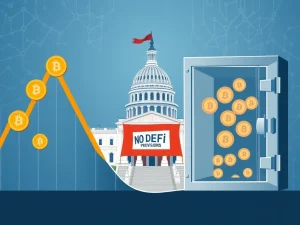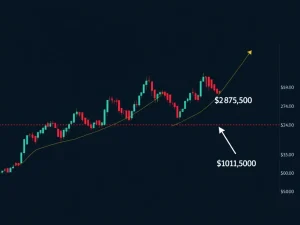Transformative Japan Crypto Tax Reforms: From 55% to a Flat 20%

Japan is on the brink of a monumental shift in its Japan crypto tax policies. Imagine a world where steep, progressive tax rates up to 55% become a flat, more manageable 20%. This promise currently captivates investors and innovators alike. The proposed reforms aim to transform Japan into a leading hub for Web3 innovation Japan, attracting both capital and talent. For years, stringent crypto tax rules have hindered growth, pushing many participants away. Now, a new era seems imminent, promising significant relief and a competitive edge for the nation’s digital asset sector.
Understanding Japan’s Current Crypto Tax Rules
Currently, investors in Japan face a challenging tax landscape. The existing system levies crypto transactions at steep, progressive rates. These rates can climb as high as 55% for individual earnings. This places digital assets at a significant disadvantage compared to traditional equities. Stocks, for instance, benefit from a flat 20% tax rate. Consequently, this disparity has discouraged domestic participation. It has also driven many traders and companies to more crypto-friendly jurisdictions. Furthermore, it has stifled the potential for robust Web3 innovation Japan. The ruling Liberal Democratic Party (LDP) recognizes these limitations. Therefore, it has committed to substantial reforms.
The current framework treats crypto gains as ‘miscellaneous income.’ This classification subjects profits to ordinary income tax rates. Such rates can range from 15% to 55%, depending on an individual’s total income. This system lacks the flexibility found in other asset classes. For example, investors cannot carry forward losses from one year to offset gains in future years. This absence of loss carry-forward provisions creates substantial risk. It makes managing volatile crypto portfolios particularly difficult. Clearly, the need for reform is pressing. The government seeks to create a more equitable and attractive environment for digital asset investment.
Proposed Reforms: A Flat 20% for Digital Assets Japan
Japan’s proposed tax regime promises a dramatic overhaul. The plan involves replacing the progressive tax rates with a flat 20% rate. This change is likely to take effect by fiscal year 2026, pending parliamentary approval. This new rate will align crypto gains with those from traditional equities. Such parity is crucial for fostering a competitive market. Moreover, these reforms are not just about tax rates. They are part of a broader strategy to integrate digital assets Japan into the mainstream financial system.
Key components of the proposed reforms include:
- Flat 20% Tax Rate: This significant reduction aims to attract investors. It will also reduce the burden on existing participants.
- Equities-like Insider Trading Regulations: New rules will prevent unfair profits. These rules will target those who use private information about token listings or protocol changes. This strengthens market fairness and investor confidence.
- Three-Year Loss Carry-Forward Provisions: Investors will gain crucial flexibility. They can carry forward losses for up to three years. This eases volatility and improves portfolio risk management. It brings crypto in line with traditional investments.
These measures collectively signal a clear intent. Japan aims to establish itself as a global hub for digital finance. Finance Minister Katsunobu Katō has openly supported crypto’s role in diversified portfolios. He acknowledges its volatility. However, he stresses the importance of building the right environment. This environment could turn crypto into a legitimate investment option. Stability and transparency are vital for investor confidence, he noted.
From Strict Oversight to Web3 Embrace: Evolving Cryptocurrency Regulation Japan
Japan’s journey with crypto regulation has been complex. In the wake of high-profile incidents, the nation adopted some of the world’s strictest regulations. The collapse of Mt. Gox in 2014 and the Coincheck hack in 2018 were pivotal. These events prompted rigorous standards. The Financial Services Agency (FSA) enforced strict rules for crypto exchanges and custody services. Furthermore, Anti-Money Laundering (AML) and Know Your Customer (KYC) practices became paramount. Cybersecurity measures were also significantly enhanced. These steps prioritized investor protection, sometimes at the expense of rapid innovation.
However, a new philosophy emerged under former Prime Minister Fumio Kishida. His administration initiated a shift towards embracing blockchain and decentralized finance (DeFi). This change forms part of his broader ‘New Capitalism’ and Web3 strategy. The government aims to retain domestic tech talent. It also seeks to remain globally competitive in the evolving digital landscape. This strategic pivot highlights a desire to balance security with innovation. Consequently, public consultations and legislative planning are now underway. These efforts will recalibrate Japan’s cryptocurrency regulation Japan. They will foster a more Web3-friendly growth environment.
The reclassification of crypto under the Financial Instruments and Exchange Act is a key development. This change would allow enforcement of insider-trading rules. It would also extend investor protections similar to those in traditional markets. Ultimately, Japan seeks to create a robust yet flexible regulatory framework. This framework will support growth while safeguarding investors.
Market Impact and Future Outlook for Japan Crypto Tax Reforms
If Japan enacts its proposed tax reforms, the impact on the crypto market could be profound. Both corporate and individual adoption of crypto will likely accelerate. Lower taxes and clearer crypto tax rules will boost liquidity. They will also attract institutional capital. Furthermore, these changes will encourage development in digital asset infrastructure. This includes exchanges, custody solutions, and Web3 projects. The reforms also align with a larger goal. Japan aims to position itself as a global digital finance hub. It seeks to compete with crypto-friendly jurisdictions like Singapore and the UAE. A regulated, investor-friendly environment will help draw global capital. It will also stimulate domestic markets. This strengthens Japan’s role in the global Web3 economy.
Optimism around these reforms is already visible. Metaplanet, Japan’s largest corporate Bitcoin holder, recently joined the FTSE Japan Index. This signals growing mainstream acceptance of digital assets Japan. On August 25, 2025, the company bought another 103 BTC. This action raised its total holdings to 18,991 BTC. Such moves underscore increasing confidence in the market’s future. Moreover, the reforms are expected to pave the way for rapid growth. This includes the emergence of yen-backed stablecoins like JPYC. These developments will further integrate crypto into Japan’s financial system.
Challenges and Laying the Groundwork for a Leading Hub
Several challenges confront Japan’s proposed Japan crypto tax reforms. The inherent volatility of digital assets prompts concerns about market stability. Investor protection remains a key focus. Regulatory enforcement presents a further hurdle. Ensuring compliance with new insider trading rules requires robust oversight. Moreover, parliamentary approval for the 20% flat tax rate may encounter delays. Political debates or competing priorities could slow the process. However, the commitment from the Liberal Democratic Party is strong. This suggests a high likelihood of eventual passage.
Ultimately, Japan’s planned 2026 reforms signal a major policy shift. They move towards investor-friendly policies and a stronger global positioning. These changes are expected to foster significant growth in the Japanese crypto industry. They will also encourage the emergence of new financial products. With these comprehensive crypto reforms, Japan is laying the groundwork. It aims to become a leading regulated cryptocurrency hub in Asia. This appeals to both retail and institutional investors. The nation offers enhanced clarity, tax parity, and robust infrastructure. This article does not contain investment advice or recommendations. Every investment and trading move involves risk, and readers should conduct their own research when making a decision.









